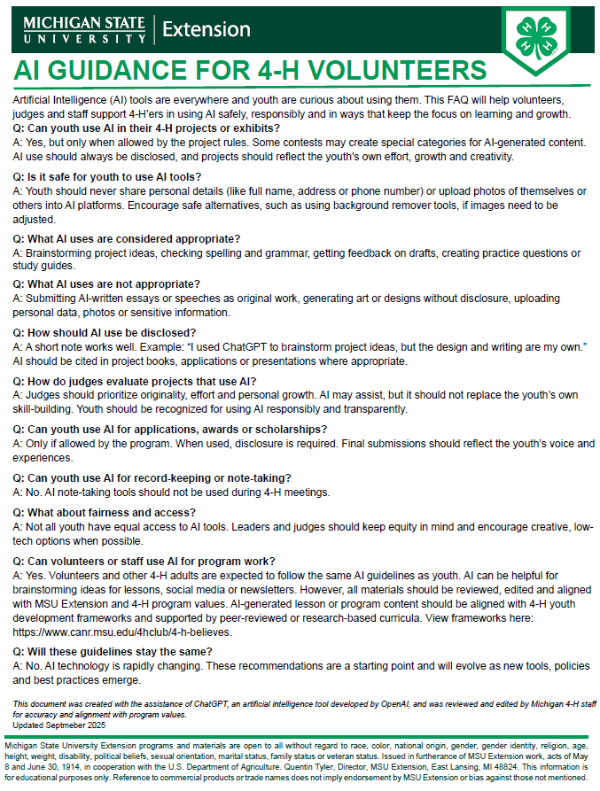
AI Guidance for 4-H Volunteers
DOWNLOADSeptember 30, 2025 - Michigan State University Extension
Artificial Intelligence (AI) tools are everywhere and youth are curious about using them. This FAQ will help volunteers, judges and staff support 4-H’ers in using AI safely, responsibly and in ways that keep the focus on learning and growth.
This document should be used in collaboration with the AI Guidance for 4-H Youth resource.
Q: Can youth use AI in their 4-H projects or exhibits?
A: Yes, but only when allowed by the project rules. Some contests may create special categories for AI-generated content. AI use should always be disclosed, and projects should reflect the youth’s own effort, growth and creativity.
Q: Is it safe for youth to use AI tools?
A: Youth should never share personal details (like full name, address or phone number) or upload photos of themselves or others into AI platforms. Encourage safe alternatives, such as using background remover tools, if images need to be adjusted.
Q: What AI uses are considered appropriate?
A: Brainstorming project ideas, checking spelling and grammar, getting feedback on drafts, creating practice questions or study guides.
Q: What AI uses are not appropriate?
A: Submitting AI-written essays or speeches as original work, generating art or designs without disclosure, uploading personal data, photos or sensitive information.
Q: How should AI use be disclosed?
A: A short note works well. Example: “I used ChatGPT to brainstorm project ideas, but the design and writing are my own.” AI should be cited in project books, applications or presentations where appropriate.
Q: How do judges evaluate projects that use AI?
A: Judges should prioritize originality, effort and personal growth. AI may assist, but it should not replace the youth’s own skill-building. Youth should be recognized for using AI responsibly and transparently.
Q: Can youth use AI for applications, awards or scholarships?
A: Only if allowed by the program. When used, disclosure is required. Final submissions should reflect the youth’s voice and experiences.
Q: Can youth use AI for record-keeping or note-taking?
A: No. AI note-taking tools should not be used during 4-H meetings.
Q: What about fairness and access?
A: Not all youth have equal access to AI tools. Leaders and judges should keep equity in mind and encourage creative, low-tech options when possible.
Q: Can volunteers or staff use AI for program work?
A: Yes. Volunteers and other 4-H adults are expected to follow the same AI guidelines as youth. AI can be helpful for brainstorming ideas for lessons, social media or newsletters. However, all materials should be reviewed, edited and aligned with MSU Extension and 4-H program values. AI-generated lesson or program content should be aligned with 4-H youth development frameworks and supported by peer-reviewed or research-based curricula. View frameworks here: https://www.canr.msu.edu/4hclub/4-h-believes.
Q: Will these guidelines stay the same?
A: No. AI technology is rapidly changing. These recommendations are a starting point and will evolve as new tools, policies and best practices emerge.
This document was created with the assistance of ChatGPT, an artificial intelligence tool developed by OpenAI, and was reviewed and edited by Michigan 4-H staff for accuracy and alignment with program values.



 Print
Print Email
Email